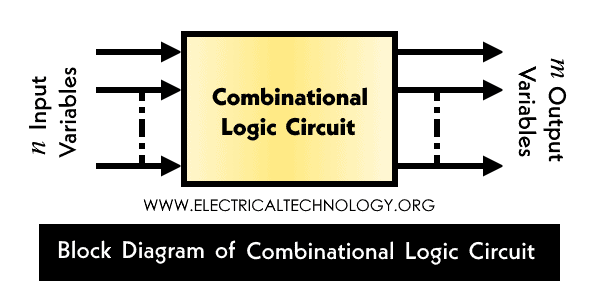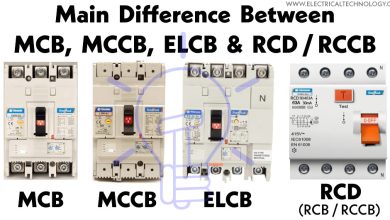Difference Between Combinational and Sequential Logic Circuits
What is the Main Difference Between Sequential and Combinational Logic Circuit?
Two fundamental building blocks widely used in digital electronics are combinational and sequential logic circuits. The following article discusses the key differences between combinational and sequential circuits, along with their respective functionalities and applications in various modern digital electronic systems.
Combinational circuits are time-independent and rely on current input values to generate immediate outputs. In contrast, sequential circuits depend on clocks and have the ability to store information about past inputs using memory elements like flip-flops.
- Related Post: Difference between digital Latch and Flip-Flop circuits
What is a Combinational Logic Circuit?
A combinational logic circuit is a type of digital circuit that produces an output based solely on the current inputs. In other words, the output of a combinational logic circuit is determined by the combination of inputs at any given moment, without regard to previous inputs or the circuit’s history.
A combination of interconnected logic gates that produces a specific Boolean function without the capability of memory or storage, is called a combinational logic circuit.
Combinational logic circuits are made up of basic logic gates such as AND, OR, NOT, NAND, NOR, and XOR gates, which are combined in various ways to perform specific logic functions.

These circuits are used in many digital systems, such as calculators, computers, and digital signal processors, to perform tasks like arithmetic operations, data processing, and control functions.
Related Posts:
What is a Sequential Logic Circuit?
A sequential logic circuit is a type of digital circuit that uses computer memory elements, such as flip-flops or latches, to store information about its state. Unlike combinational logic circuits, which rely solely on the current inputs to produce an output, sequential logic circuits also consider the circuit’s previous state.
A sequential circuit is essentially a timing and memory device where flip-flops are the fundamental blocks. In short, it is a feedback path between a combinational circuit and memory elements.
Sequential logic circuits have feedback paths that allow them to “remember” past inputs and use this information to determine their current output. These circuits are used in applications where the output depends not only on the current inputs but also on the past sequence of inputs. Examples include memory units, counters, and state machines.

Related Posts:
- Difference between Photodiode and Photoresistor (LDR)
- Difference Between Photodiode and Phototransistor
Comparison Between Combinational and Sequential Logic
The following table shows the comparison between sequential and combination logic circuits.
| Parameters | Combinational Circuits | Sequential Circuits |
| Definition | It is a type of digital circuit where the output is solely determined by the current input and is not influenced by previous inputs or the circuit’s own internal state. | It is a digital circuit that uses memory elements (like flip-flops) to store information, allowing the output to depend not only on the current input but also on past inputs and the circuit’s internal state. |
| Behavior | Outputs variables depend only on current inputs variables | Outputs variables depend on current inputs variables and past states |
| Memory | No memory elements | Contains memory elements (e.g., flip-flops) |
| Output Changes | Immediate response to input changes | Response synchronized with clock signal |
| Clock | No Clock | There is a clock |
| Feedback | No feedback | Uses feedback for memory and state information |
| Components | Basic logic gates | Flip-flops, latches, and combinational logic |
| Output Determination | Solely based on input values | Based on current inputs and past states |
| Speed | Faster in speed because the delay between Input & Output is due to in propagation delay of gates. | Comparatively slower than Combinational circuits. |
| Design Complexity | Generally simpler | More complex due to timing and memory elements |
| Examples | Parallel Adders, half-adders, multiplexers, de-multiplexers, encoders, decoders, comparators | Counters, registers, serial adders, finite state machines, flip-flops |
| Applications | Arithmetic and logic operations | Memory units, control units, sequential tasks |
Related Posts:
Differences Between Combinational and Sequential Circuits
Below are the key differences between combinational and sequential logic circuits:
Behavior:
-
- Combinational Logic: Outputs depend only on the current input values, with no regard to past inputs or outputs.
- Sequential Logic: Outputs depend on both the current input values and the past sequence of inputs.
Memory:
-
- Combinational Logic: Does not have memory elements; output is purely a function of current inputs.
- Sequential Logic: Contains memory elements (flip-flops or latches) that allow it to store information about past inputs and outputs.
Output Changes:
-
- Combinational Logic: Output changes immediately when there is a change in input.
- Sequential Logic: Output changes based on a clock signal and the current and past inputs.
Feedback:
-
- Combinational Logic: Does not use feedback; output is determined solely by input values.
- Sequential Logic: Uses feedback to store information and generate output based on both current inputs and past states.
Design Complexity:
-
- Combinational Logic: Generally simpler to design and analyze.
- Sequential Logic: More complex due to the presence of memory elements and the need to consider timing and clock signals.
Components:
-
- Combinational Logic: Built using basic logic gates (AND, OR, NOT, etc.) and their combinations.
- Sequential Logic: Built using flip-flops, latches, and combinational logic components.
Examples:
-
- Combinational Logic: Adders, multiplexers, decoders, etc.
- Sequential Logic: Counters, registers, finite state machines (FSMs), etc.
Applications:
-
- Combinational Logic: Used in circuits where outputs depend only on current inputs, such as arithmetic and logic operations.
- Sequential Logic: Used in circuits where outputs depend on both current inputs and past states, such as in memory units and control units.
Related posts compare and contrast various electrical and electronic components and devices.
- Difference Between Fast Recovery Diode and Step Recovery Diode
- Difference Between Schottky Diode and Fast Recovery Diode
- Difference Between Phototransistor and Photoresistor (LDR)
- Difference Between JFET and MOSFET
- Difference Between BJT and FET Transistors
- Difference Between Diode and SCR (Thyristor)
- Difference Between Transistor & Thyristor (SCR)
- Difference Between Diode and Transistor
- Difference Between NPN and PNP Transistor
- Difference Between Inverting and Non-Inverting Amplifier
- Difference Between Amplifier and Operational Amplifier
- Difference Between Voltage Source and Current Source
- Difference between Voltage Source Inverter & Current Source Inverter
- Difference between Inverter & UPS – Uninterruptible Power Supply
- Difference Between Encoder and Decoder
- Difference Between Microprocessor and Microcontroller
- Difference Between 8085 & 8086 Microprocessor – Comparison
- Difference Between RAM and ROM – Comparison
- Difference Between CPU and GPU – Comparison
- Difference between Active and Passive Components
- Difference Between Multiplexer (MUX) & Demultiplexer (DEMUX)
- Main Difference Between Sensor and Actuator
- Main Difference between Sensor and Transducer
- Difference between Zener Diode and Avalanche Diode







